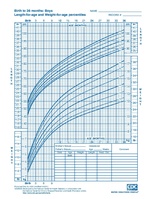
Indications for stenting of coarctation of the aorta in children under 3 months of age
Sign Up to like & getrecommendations! Published in 2020 at "Netherlands Heart Journal"
DOI: 10.1007/s12471-020-01371-8
Abstract: Introduction Coarctation of the aorta in children under 3 months of age is usually treated surgically. However, there are clinical scenarios in which stenting of native or recurrent coarctation may become necessary in this age group.… read more here.
Keywords: coarctation aorta; coarctation; age; children months ... See more keywords

Characteristics of Children ≤36 Months of Age with Diffuse Intrinsic Pontine Glioma (DIPG): A Report from the International DIPG Registry.
Sign Up to like & getrecommendations! Published in 2022 at "Neuro-oncology"
DOI: 10.1093/neuonc/noac123
Abstract: BACKGROUND Children ≤36 months with Diffuse Intrinsic Pontine Glioma (DIPG) have increased long-term survival (LTS, overall survival (OS) ≥24 months). Understanding distinguishing characteristics in this population is critical to improving outcomes. METHODS Patients ≤36 months… read more here.
Keywords: children months; intrinsic pontine; registry; pontine glioma ... See more keywords

Effect of early childhood development interventions delivered by healthcare providers to improve cognitive outcomes in children at 0–36 months: a systematic review and meta-analysis
Sign Up to like & getrecommendations! Published in 2023 at "Archives of Disease in Childhood"
DOI: 10.1136/archdischild-2022-324506
Abstract: Objective To determine the effect of early childhood development interventions delivered by healthcare providers (HCP-ECD) on child cognition and maternal mental health. Design Systematic review, meta-analysis. Setting Healthcare setting or home. Participants Infants under 1 month… read more here.
Keywords: children months; effect; development; childhood ... See more keywords

Simplified dosing of oral azithromycin for children 1–11 months old in child survival programmes: age-based and height-based dosing protocols
Sign Up to like & getrecommendations! Published in 2022 at "BMJ Global Health"
DOI: 10.1136/bmjgh-2022-009801
Abstract: Background To facilitate mass distribution of azithromycin, trachoma control programmes use height instead of weight to determine dose for children 6 months to 15 years old. WHO has recommended azithromycin distribution to children 1–11 months old… read more here.
Keywords: height based; children months; age based; based dosing ... See more keywords

Risk factors for early childhood growth faltering in rural Cambodia: a cross-sectional study
Sign Up to like & getrecommendations! Published in 2022 at "BMJ Open"
DOI: 10.1136/bmjopen-2021-058092
Abstract: Objective This study aimed to determine risk factors of growth faltering by assessing childhood nutrition and household water, sanitation, and hygiene (WASH) variables and their association with nutritional status of children under 24 months in… read more here.
Keywords: children months; growth; water; level ... See more keywords

Parents’ perspective on COVID-19 vaccine in children 6 months through 4 years: a cross-sectional study from Northwest Wisconsin
Sign Up to like & getrecommendations! Published in 2022 at "BMJ Open"
DOI: 10.1136/bmjopen-2022-065453
Abstract: Vaccination is critical to control the ongoing COVID-19 pandemic, but despite the availability of safe and effective vaccine in children over 5 years, vaccination rates remain low. There is paucity of data about vaccine acceptance… read more here.
Keywords: vaccine children; children months; months years; covid vaccine ... See more keywords

Think Twice before Interpreting the Skin Prick Test as Age, Body Mass Index, and Atopy Affect Reaction Time and Size
Sign Up to like & getrecommendations! Published in 2021 at "International Archives of Allergy and Immunology"
DOI: 10.1159/000515414
Abstract: Introduction: The skin prick test (SPT) is a reliable method to confirm sensitization in IgE-mediated allergic diseases; however, it has been reported to be affected by several personal and environmental factors. Our objective was to… read more here.
Keywords: age; skin prick; time; children months ... See more keywords

Timing and pattern of growth faltering in children up-to 18 months of age and the associated feeding practices in an urban setting of Sri Lanka
Sign Up to like & getrecommendations! Published in 2022 at "BMC Pediatrics"
DOI: 10.1186/s12887-022-03265-7
Abstract: Background Growth faltering is commonly encountered in breastfed infants during 4—6 months of age in low socioeconomic communities. The objective of this study was to describe the changes of growth indices with age, timing of growth… read more here.
Keywords: months age; feeding practices; growth; growth faltering ... See more keywords

Age-based targeting of biannual azithromycin distribution for child survival in Niger: an adaptive cluster-randomized trial protocol (AVENIR)
Sign Up to like & getrecommendations! Published in 2021 at "BMC Public Health"
DOI: 10.1186/s12889-021-10824-7
Abstract: Background Biannual distribution of azithromycin to children 1–59 months old reduced mortality by 14% in a cluster-randomized trial. The World Health Organization has proposed targeting this intervention to the subgroup of children 1–11 months old to reduce… read more here.
Keywords: trial; children months; mortality; biannual azithromycin ... See more keywords

The timing of growth faltering has important implications for observational analyses of the underlying determinants of nutrition outcomes
Sign Up to like & getrecommendations! Published in 2018 at "PLoS ONE"
DOI: 10.1371/journal.pone.0195904
Abstract: Background Growth faltering largely occurs in the first 23 months after birth and is thought to be largely determined by various harmful or protective socioeconomic conditions. Children 23 months or younger, however, have only been… read more here.
Keywords: underlying determinants; observational analyses; age; growth faltering ... See more keywords

CONSUMPTION OF ULTRA-PROCESSED FOODS BY CHILDREN UNDER 24 MONTHS OF AGE AND ASSOCIATED FACTORS
Sign Up to like & getrecommendations! Published in 2020 at "Revista Paulista de Pediatria"
DOI: 10.1590/1984-0462/2020/38/2018277
Abstract: ABSTRACT Objective: To evaluate the intake of ultra-processed foods by children under 24 months of age from the city of Montes Claros and identify factors associated with this consumption. Methods: This is a population-based cross-sectional… read more here.
Keywords: age; children months; ultra processed; foods children ... See more keywords